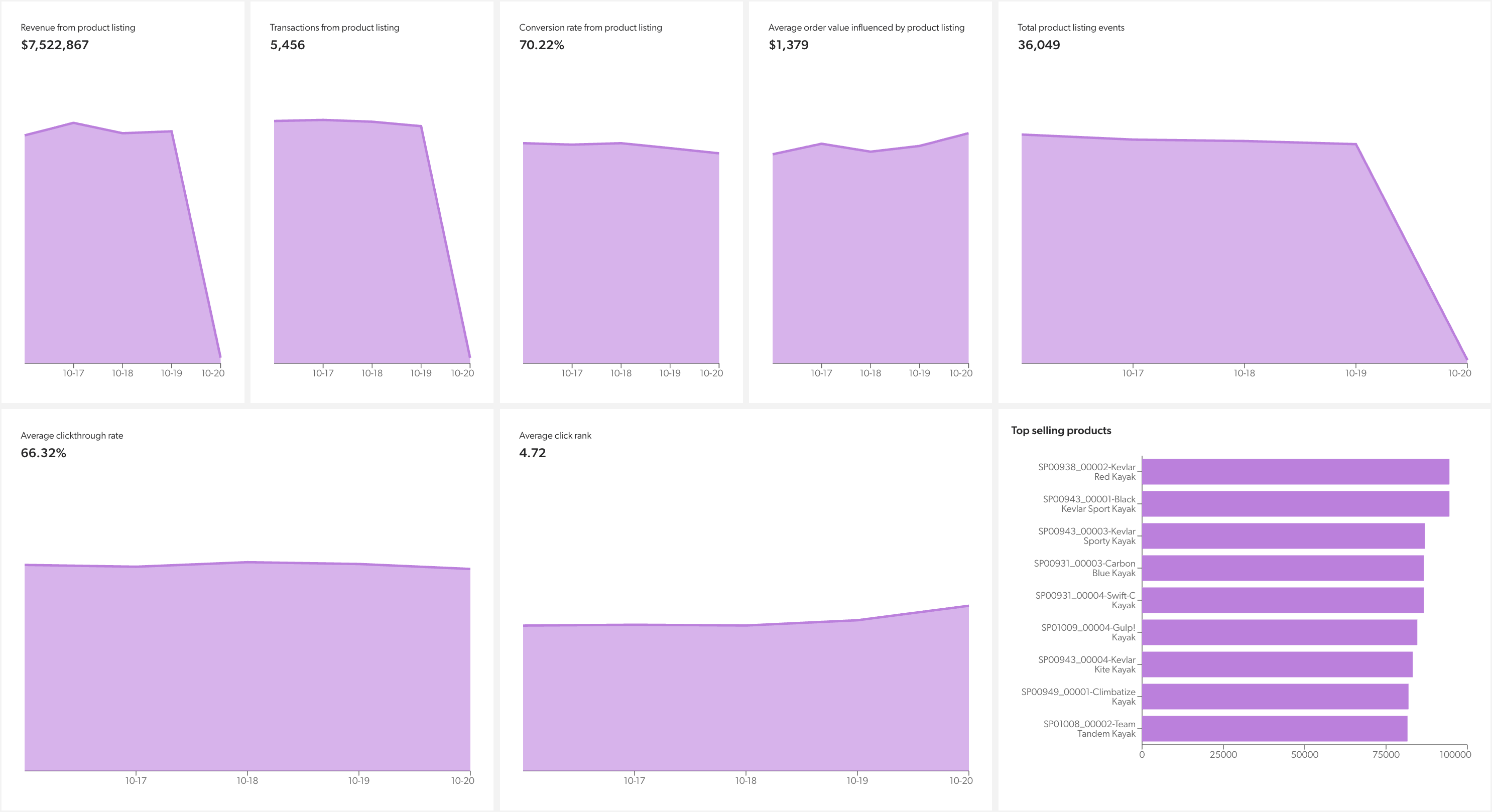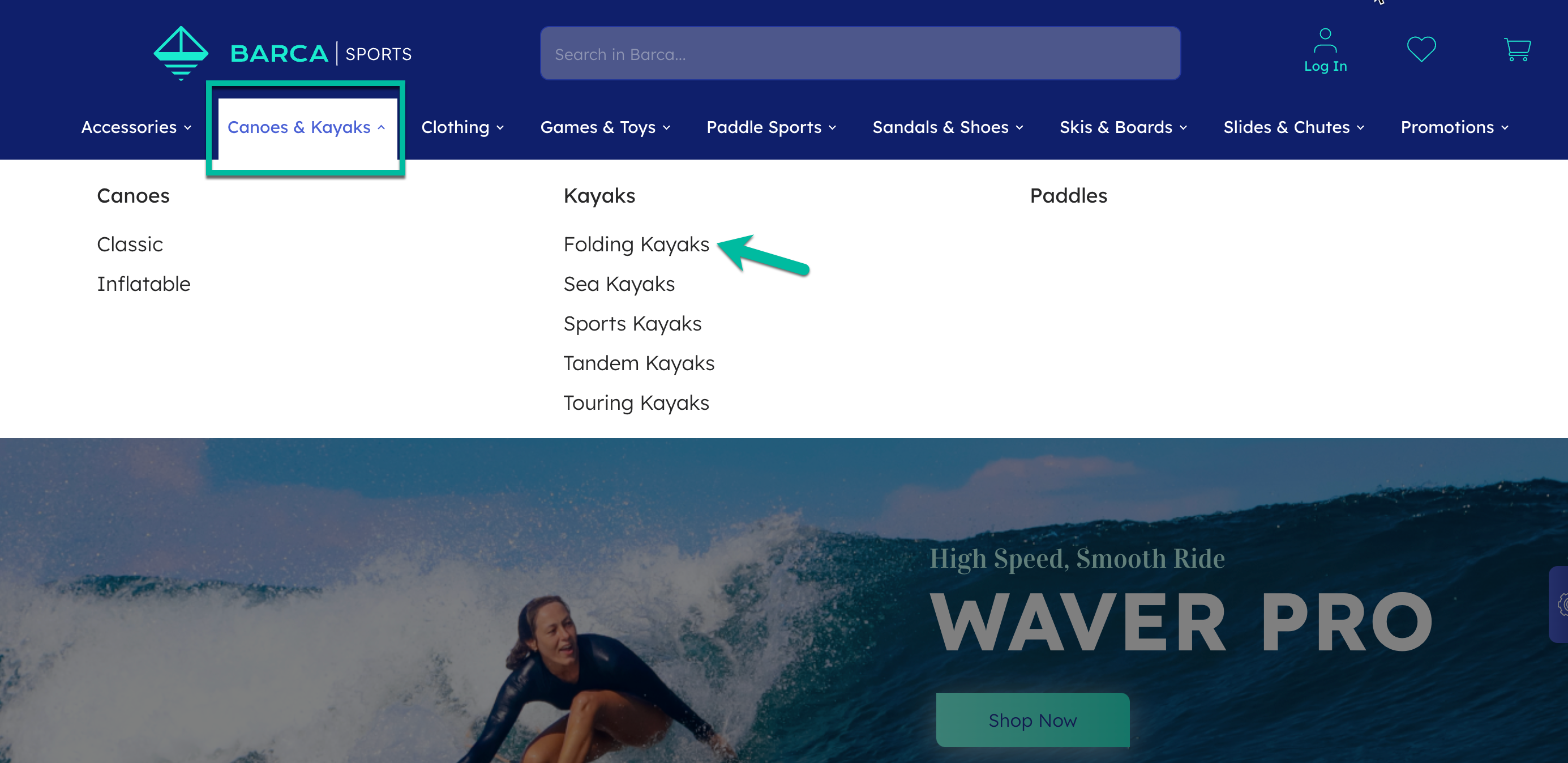Product listing dashboard
Product listing dashboard
- What’s a session?
- What’s a product listing event?
- What’s product listings attribution?
- Item revenue from product listing chart
- Transactions from product listing chart
- Conversion rate from product listing chart
- Average order value influenced by product listing chart
- Average clickthrough rate chart
- Average click rank chart
- Total product listing events chart
- Top selling products chart
The Product listing dashboard of the Advanced Reports (platform-ca | platform-eu | platform-au) page provides an in-depth view of the top performing product listing pages. Like in the Overview dashboard, you can view basic metrics such as revenue, conversion rate, clickthrough rate, and more. However, the Product listing dashboard provides an emphasis on product listing attributions.

The Product Listings dashboard comprises the following metric charts:
What’s a session?
Although sessions aren’t specifically listed in the Product Listings dashboard, they’re often used in the calculation of the metrics listed in the dashboard.
At Coveo, a session (or visit) starts on the first event a visitor (customer) generates and ends after 30 minutes of inactivity.
For a given visitor, this means that if a new event is generated after 30 minutes of inactivity, this results in a new session, and a new visit ID is generated.
To be considered Coveo-related, the session must contain either search actions, listing actions, and/or recommendations actions.
What’s a product listing event?
In this article, the term product listing event is often used in metric definitions to simplify the explanation.
However, a product listing event isn’t an official Coveo Usage Analytics (Coveo UA) event type.
In practice, a product listing event is a search event triggered when a product listing page loads.
This happens when a query to the Search API is made to retrieve the products to display on the page.
The query must contain listing in the searchHub query parameter to trigger a product listing event.
What’s product listings attribution?
The Product listings dashboard shows the extent to which Coveo-powered product listing pages have contributed to the performance of your key commerce metrics.
If the visitor’s last action before adding the product to their cart was to click a search result that was shown on a product listing page they accessed by selecting a product category, Coveo attributes the purchase to the Coveo product listings service.

In this case, selecting a product category sends a request to the Search API, which generates a unique ID called searchUid.
Sending this request causes the product listing page to load and display products that are relevant to the selected category, which sends a search event to Coveo UA.
This search event contains in its payload a searchQueryUid property which is filled with the value of the searchUid returned by the request to the Search API.
When the visitor clicks a product, the click event sent to Coveo includes the searchQueryUid property filled with the value of the searchUid generated by the search query.
By tracking the unique ID value used throughout the actions leading up to the purchase, Coveo can determine that the Coveo Listings service was responsible for the purchase.
Item revenue from product listing chart
The Item revenue from product listing chart displays the total revenue influenced by Coveo product listing pages that were consulted within the chosen filters.
The line graph delineates the variance of the total over a specific period of time.
How’s the item revenue from product listing calculated?
Item revenue from product listings is calculated by adding up the revenue from every product sold in each purchase event that was attributed to product listing events.
|
|
Note
Revenue is reported in Gross revenue includes the taxes, shipping costs, and discounts, whereas net revenue excludes the taxes and shipping costs. All reported revenue metrics use gross revenue (unless otherwise stated), except for the Top selling products metric, which display net revenue figures. See About revenue for more information on how the revenue metrics are calculated. |
Transactions from product listing chart
The Transactions from product listing chart displays the total number of purchase events influenced by product listing pages that were consulted within the chosen filters.
The line graph delineates the variance of the total over a specific period of time.
How are the transactions from product listing calculated?
The total number of commerce events that contain the purchase action and attributed to product listing events.
See Capture a purchase event for more information on how purchase events are logged and measured.
Conversion rate from product listing chart
The Conversion rate from product listing chart displays the number of transactions that was attributed to Coveo product listing pages over the total number of sessions, within the chosen filters.
The line graph delineates the variance of the percentage over a specific period of time.
How’s the conversion rate from product listing calculated?
The number of transactions attributed to Coveo product listing pages divided by the total number of sessions in which at least one Coveo product listing search event occurred, multiplied by 100.
Average order value influenced by product listing chart
The Average order value influenced by product listing chart displays the average revenue per transaction event influenced by Coveo product listing pages, within the chosen filters.
The line graph delineates the variance of the average over a specific period of time.
How’s the average order value influenced by product listing calculated?
Dividing the sum of the total revenue attributed to product listing events by the total number of transactions attributed to product listing events.
Average clickthrough rate chart
The Average clickthrough rate chart displays the percentage of search events influenced by Coveo product listing pages that were followed by at least one related click event out of the total number of search events influenced by Coveo product listing pages that were consulted within the chosen filters.
The line graph delineates the variance of the average clickthrough rate over a specific period of time.
How’s the average clickthrough rate calculated?
The total number of listing search event that were followed by at least one click event (with a matching searchQueryUid value), divided by the total number of listing search events.
Average click rank chart
The Average click rank chart displays the average position of a product when customers have clicked or interacted with it on a product listings page, within the chosen filters.
The line graph delineates the variance of the average click rank over a specific period of time.
|
|
A lower click rank is better because this means that the product was well positioned. |
How’s the average click rank calculated?
The average of the documentPosition value for all click events that followed a Coveo product listing search event.
Total product listing events chart
The Total product listing events chart displays the total number of searches triggered by a click action on any web category, within the chosen filters.
The line graph delineates the variance of the total over a specific period of time.
How are product listing events calculated?
The total number of product listing events.
Top selling products chart
A list of the top 10 clicked products or product groups on listing pages that generated the most revenue, within the chosen filters.
How are top selling products calculated?
The products or product groups contained in click events that followed a Coveo product listing search event to which a purchase was attributed and that generated the most revenue.